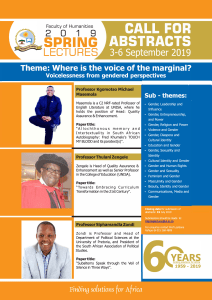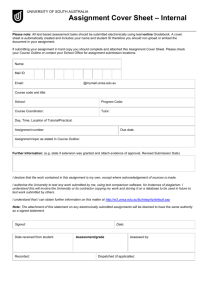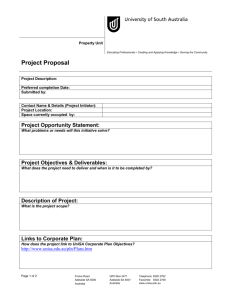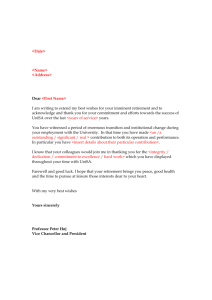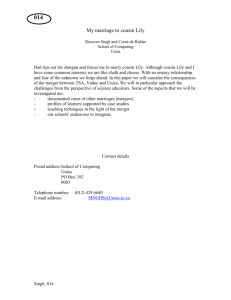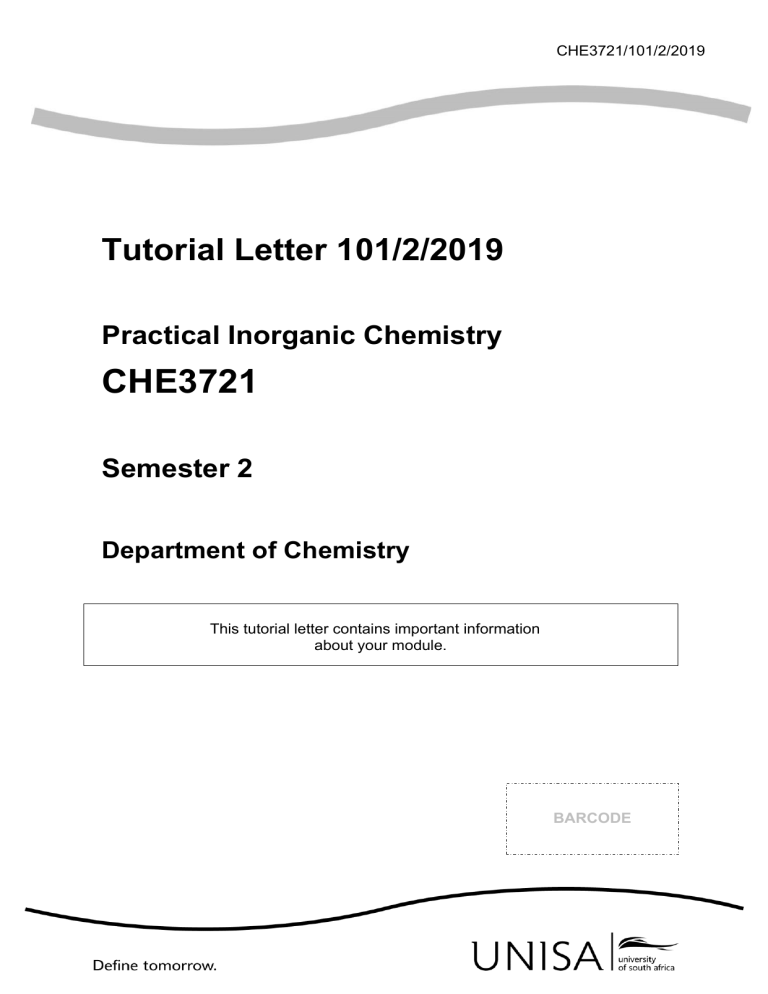
CHE3721/101/2/2019 Tutorial Letter 101/2/2019 Practical Inorganic Chemistry CHE3721 Semester 2 Department of Chemistry This tutorial letter contains important information about your module. BARCODE CONTENTS Page 1 INTRODUCTION ............................................................................................................................ 3 2 PURPOSE AND OUTCOMES ........................................................................................................ 3 2.1 Purpose .......................................................................................................................................... 3 2.2 Outcomes ....................................................................................................................................... 4 3 LECTURER(S) AND CONTACT DETAILS .................................................................................... 4 3.1 Lecturer(s) ...................................................................................................................................... 4 3.2 Department ..................................................................................................................................... 4 3.3 University ........................................................................................................................................ 5 4 RESOURCES ................................................................................................................................. 5 4.1 Prescribed book(s) .......................................................................................................................... 5 4.2 Recommended book(s) .................................................................................................................. 5 4.3 Electronic reserves (e-reserves) ..................................................................................................... 6 4.4 Library services and resources ....................................................................................................... 6 5 STUDENT SUPPORT SERVICES ................................................................................................. 7 6 STUDY PLAN ................................................................................................................................. 7 7 PRACTICAL WORK ....................................................................................................................... 7 8 ASSESSMENT ............................................................................................................................... 8 8.1 Assessment criteria ........................................................................................................................ 8 8.2 Assessment plan ............................................................................................................................ 9 8.3 Assignment numbers ...................................................................................................................... 9 8.3.1 General assignment numbers ......................................................................................................... 9 8.3.2 Unique assignment numbers .......................................................................................................... 9 8.4 Assignment due dates .................................................................................................................... 9 8.5 Submission of assignments ............................................................................................................ 9 8.6 The assignments .......................................................................................................................... 11 8.7 Other assessment methods .......................................................................................................... 17 8.8 The examination ........................................................................................................................... 17 9 FREQUENTLY ASKED QUESTIONS .......................................................................................... 17 10 SOURCES CONSULTED ............................................................................................................. 17 11 IN CLOSING ................................................................................................................................. 17 12 ADDENDUM ................................................................................................................................. 17 2 CHE3721/101/2/2019 1 INTRODUCTION Dear Student We are pleased to welcome you to this module (CHE3721) and hope that you will find it both interesting and rewarding. We shall do our best to make your study of this module successful. You will be well on your way to success if you start studying early in the semester/ year and resolve to do the practical work properly. This tutorial letter is our way of communicating with you about the modus operandi of our laboratory teaching, learning and assessment. You will receive the lab manual, which has detailed work programs for the laboratory work when you come to the practicals by the beginning of June. We have also included certain general and administrative information about laboratory work in this module. Please study this section of the tutorial letter carefully. Please note that this module deals with the practical aspects of the theory module CHE3701. We hope that you will find the module interesting and rewarding. We shall do our best to make your study of this module successful. You will be well on your way to success if you start studying early in the semester and resolve to do the assignments properly. 2 PURPOSE AND OUTCOMES 2.1 Purpose The purpose of this course is to motivate students to understand the fundamental concepts of electronic structure and spectra in d metal complexes and coordination compounds and organometallic chemistry. Learning outcomes (i) The students will be introduced to the basic experimental foundations of electronic structure and spectra of d-metal complexes by using synthetic methods and instrumental techniques such as Uv-Vis and infrared spectrophotometry. (ii) The experiments will be designed in such a way that students will get a better insight in to the theoretical principles covering the following concepts: a) Werner coordination compounds b) Ligand field theory c) Structure and bonding d) Inorganic reaction mechanisms e) Organometallic compounds (iii) The students will be given the opportunity to apply their knowledge and skills gained to practical situations in advanced inorganic chemistry. 3 2.2 Outcomes GOALS OF THIS LABORATORY COURSE: 1. Strengthen theoretical knowledge: expansion your understanding of the principles you have learned, or are learning, in the lecture component of this course. 2. Strengthen experimental competence and confidence: You will get the chance in this laboratory component to increase your exposure to various kinds of synthetic methods and analytical instrumentation. Where you use instruments, which you have been previously exposed to, you will learn new applications for them. 3. Learn how to write reports: You will write complete reports for all of the experiments which you will perform in this laboratory class. Use A.C.S. style; look in the Journal of the American Chemical Society or Inorganic Chemistry for examples. 3 LECTURER(S) AND CONTACT DETAILS 3.1 Lecturer(s) The lecturer responsible for this module is Lecturer’s name: Prof HS Clayton Department of Chemistry College of Science, Engineering & Technology Eureka Building, Block K- M 028 clayths@unisa.ac.za 011 670 9310 3.2 Department Department of Chemistry College of Science, Engineering & Technology Eureka Building, Block K- M 042 chemistry@unisa.ac.za 011 670 9318/9327 4 CHE3721/101/2/2019 3.3 University Communication with the University If you need to contact the University about matters not related to the content of this module, please consult the publication My studies @ Unisa that you received with your study material. This booklet contains information on how to contact the University (e.g. to whom you can write for different queries, important telephone and fax numbers, addresses and details of the times certain facilities are open). Always have your student number at hand when you contact the University. PLEASE NOTE: assignments. Letters to lecturers may not be enclosed with or inserted into 4 RESOURCES 4.1 Prescribed book(s) There is no prescribed textbook for CHE3721. This means that you do not have to buy any additional books for CHE3721. You need only study your study guide, prescribed textbook for the theory module, CHE3701 and the tutorial letters. The prescribed textbook for CHE3701 is Shriver, Atkins, Overton, Rourke, Weller and Armstrong Inorganic chemistry, 6th edition, 2014 (ISBN 9780199641826), Oxford university press. The University does not provide copies of this book. Students are expected to obtain their own copies. As most of the study material for this module is included in this book, it is essential to have access to a copy of the textbook. You may use the fourth and fifth edition as well if you are unable to get hold of the sixth edition. However, note that the page numbers and arrangement of the chapters is different. The content of the chapters is more or less similar. 4.2 Recommended book(s) The following are publications that you may consult in order to broaden your knowledge of inorganic chemistry. S.F.A. Kettle, Physical inorganic chemistry: A coordination approach, Oxford University Press. F.A. Cotton, G. Wilkinson and P.L. Gaus, Basic Inorganic Chemistry, John Wiley and Sons. B. Douglas, D. McDaniel and J. Alexander, Concepts and Models of Inorganic Chemistry, John Wiley and Sons. J. E. Huheey, Inorganic Chemistry: Principles of Structure and Reactivity, Harper and Row. 5 The following books are useful reference books: J.C. Bailar, H.J. Emeléus, R. Nyholm and A. F. Trotman-Dickenson (eds.), Comprehensive Inorganic Chemistry (5 Volumes), Pergamon Press. F. A. Cotton and G. Wilkinson, Advanced Inorganic Chemistry, John Wiley and Sons. N. N. Greenwood and A. Earnshaw, Chemistry of the Elements, Pergamon Press. G. Wilkinson, R.D. Gillard and J. A. McCleverty (eds.), Comprehensive Coordination Chemistry ( 5 Volumes), Pergamon Press. [Please enter authors and book titles only. No book numbers please, as this system is no longer used by the Library.] Recommended books can be requested online, via the Library catalogue. 4.3 Electronic reserves (e-reserves) There are no e-reserves for this module. E-reserves can be downloaded from the Library catalogue. More information is available at: http://libguides.unisa.ac.za/request/request. 4.4 Library services and resources The Unisa Library offers a range of information services and resources: for detailed Library information go to http://www.unisa.ac.za/sites/corporate/default/Library for research support and services (e.g. personal librarians and literature search services) go to http://www.unisa.ac.za/sites/corporate/default/Library/Libraryservices/Research-support The Library has created numerous Library guides: http://libguides.unisa.ac.za Recommended guides: 6 Request and download recommended material: http://libguides.unisa.ac.za/request/request Postgraduate information services: http://libguides.unisa.ac.za/request/postgrad Finding and using library resources and tools: http://libguides.unisa.ac.za/Research_skills Frequently asked questions about the Library: http://libguides.unisa.ac.za/ask CHE3721/101/2/2019 5 Services to students living with disabilities: http://libguides.unisa.ac.za/disability STUDENT SUPPORT SERVICES The Study @ Unisa brochure is available on myUnisa: www.unisa.ac.za/brochures/studies This brochure has all the tips and information you need to succeed at distance learning and, specifically, at Unisa. 5.1 Study Groups Students who wish to form study groups can obtain the addresses of fellow students in a specific area from the: The Directorate: Student Administration and Registration PO Box 392 UNISA 0003 6 STUDY PLAN The myUnisa Learning Management System The myUnisa Learning Management System is the online campus network that enables each student to communicate via the internet with academic staff, fellow students and the administrative departments within UNISA. Students can also access resources and information from the university. Use your my Studies @ Unisa brochure for general time management and planning skills. 7 PRACTICAL WORK Students are required to attend a compulsory practical course CHE3721 of five day’s duration to complete the requirement for the third level inorganic chemistry module. Students can co-register with the theory component CHE3701 or may opt to take the practical component after successfully passing the theory module. The admission criteria to the practical session are given below. The venue for the practical is Inorganic chemistry lab. Eureka building, CSET Florida campus. The exact dates for the practical will be given in tutorial letter 301. Please check my UNISA updates. 7 7.1 ADMISSION TO PRACTICALS Students who have already passed the theory module from previous semester/years will be granted automatic admission to the practical. If you have already passed the theory module in previous years you don’t need to submit the first assignment for purposes of admission. The successful passing of the theory module in previous years will grant you admission to the practical module automatically. Please inform the instructor before the first assignment deadline when you passed the theory module and the mark you obtained by e-mail so that your name will be included in the qualifying list. For those students who have concurrently registered for both the theory (CHE3701) and practical (3721) during the second semester, admission to the third year Inorganic practical (CHE3721) depends on getting a minimum of 50% in the first assignment of the second semester theory module (CHE3701). Eligible students will be informed about the practical dates in due course by the department. 7.2 PRACTICAL WORK AT OTHER UNIVERSITIES Students who are unable to attend the practicals at the scheduled time may do the practicals at another university. Such students have to request approval from the Head of Department of Chemistry at UNISA to ascertain whether a particular practical course will be accredited by UNISA. However, gaining access to a specific institution is solely the responsibility of the student. Exemptions from any of the third level chemistry modules is not allowed. Students who have completed any third year level Chemistry practical course at another university MUST register for the corresponding practical module of the sub-discipline of Chemistry (e.g. CHE3721) at UNISA. Such applications must be accompanied by formal communication from the Department of Chemistry at the other university indicating that the student attended the practical course, details of the syllabus of the practical course, the year in which it was attended and the mark obtained. All applications for the credit transfer must be made in writing to the Head of the Department of Chemistry at UNISA. 8 ASSESSMENT 8.1 Assessment criteria The assessment for the practical work consists of the following. Lab note book 30% Answers to lab 1 questions 15% Answers to lab 2 questions 12.5% Answers to lab 3 questions 17.5% Answers to lab 4 questions 12.5% Answers to lab 5 questions 12.5% 8 CHE3721/101/2/2019 Note that the final module mark will be computed as 20% continuous assessment ie that is assignments 1 and 2 and 80 % the lab mark. 8.2 Assessment plan The final mark is composed of 20% year mark (from assignments 1 and 2) and 80% of portfolio (lab report and practical work). Please note: Although students may work together when preparing assignments, each student must write and submit his or individual assignment. In other words, you must submit your own ideas in your own words, sometimes interspersing relevant short quotations that are properly referenced. It is unacceptable for students to submit identical assignments on the basis that they worked together. That is copying (a form of plagiarism) and none of these assignments will be marked. Furthermore, you may be penalized or subjected to disciplinary proceedings by the University. 8.3 Assignment numbers 8.3.1 General assignment numbers The two assignments contribute 20% to your final mark. The lab report and practical work contribute the remaining 80% for the final mark. Please note that your admission to the practical depends on your performance in the first assignment of semester 2 if you are registering for both the theory and practical module during the second semester. Also note that the assignments are identical to those of the theory module. The only difference is the unique numbers. 8.3.2 Unique assignment numbers Assignment 1 : Unique no: 833334 Assignment 2 : Unique no: 745229 8.4 Assignment due dates Assignment 1: 12 August 2019 Assignment 2: 11 September 2019 8.5 Submission of assignments You may submit written assignments either by post or electronically via myUnisa. Assignments may not be submitted by fax or e-mail. For detailed information and requirements as far as assignments are concerned, see the brochure Unisa: Services and Procedures that you received with your study material. 9 To submit an assignment via myUnisa: 10 Go to myUnisa. Log in with your student number and password. Select the module. Click on assignments in the left-hand menu. Click on the assignment number you want to submit. Follow the instructions on the screen. CHE3721/101/2/2019 8.6 The assignments Assignment 1 (compulsory for admission to the practical for students that have registered both theory and practical concurrently in the second semester). Semester 2. Note that the assignments are identical to CHE3701 semester 2. It is only the unique number that is different. SEMESTER 2 Assignment 1: Due date: 12 August 2019 Unique no: 833334 Before doing this assignment study the following: Units 1 and 2 from the study guide and chapters 7, 8 and 20 from the course textbook. Part I. Multiple choice questions: Write the letter of your choice in your answer book. You have to give the rational why you chose the answer for full credit. The correct choice gives you one mark while the rationale also carries one mark. The multiple choice section hence carries two points per question. 1. A solution of 0,001mol dm-3 NiSO4 is placed in an optical cell of path length 1 cm, and the absorption spectrum recorded. The absorptions have characteristic λmax and εmax values. What are the correct units of εmax? A. cm mol dm-3 B. cm dm3 mol-1 C. dm3 mol-1 cm-1 D. mol dm-3 cm-1 2. Which of the following is the principal chromophore in an azo-dye? A. N=N B. CN-1 C. C=N D. N2 11 3. All but one of the following groups can donate a lone pair of electrons into the carbon π system of a conjugated polyene. Which is the odd one out? A. NMe2 B. OMe C. Me D. SMe 4. Which of the following statements is consistent with an electronic absorption being broad? A. Hydrogen bonding causes an electronic absorption to be broad B. Electronic transitions are always localized on a single atomic center C. The absorption of a photon is slower than the timescale of molecular vibrations D. An electronic absorption includes vibrational and rotational structures 5. The coordination complex, [Cu(OH2)6]2+ has one unpaired electron. Which of the following statements are true? (1) The complex is octahedral. (2) The complex is an outer orbital complex. (3) The complex is d2sp3 hybridized. (4) The complex is diamagnetic. (5) The coordination number is 6. (A) 1, 4 (B) 1, 2, 5 (C) 2, 3, 5 (D) 2, 3 (E) 4, 5 12 CHE3721/101/2/2019 Part II. Question 1 carries 20 marks. The rest carry 10 marks each 1a. Draw the structure of the complex ion cis-acetylactonatodichloroplatinate(II). b. Draw the structure of bromo-cis-dimethyl-mer-tris(trimethylphosphine)cobalt(III) c. Draw all possible isomers of [Co(py)2(SCN)2], given that it is a tetrahedral complex. 2. Determine the spin only magnetic moments of the following: a) Cu+ ion b) [FeCl4]2- 3. Bearing in mind the Jahn- Teller theorem, rank the following compounds in terms of their degree of deviation from an idealized octahedral structure: [Cr(CN)6]4-, [Cu(OH2)6]2+, and [Cr(OH2)6]3+. Explain your reasoning and indicate what type of distortion can be expected (use drawings as required). 4a Explain why an electronic transition for high spin [MnF6]4- is spin-forbidden, but for [CoF6]4- is spin-allowed. 4b. Why are d-d electronic transitions forbidden in octahedral coordination entities? Why are they weakly absorbing and why do they occur at all? 5. Name the following compounds. a) [Cr(NH3)6]Cl3 b) K2[FeO4] c) [Cr(NH3)2(H2O)3(OH)](NO3)2 d) Ni(en)2Cl2 e) K[PtCl3(C2H4)] 6. Predict the spin state (high- or low-spin) for each complex and calculate CFSE. Indicate your reasoning in each case. a) Fe(H2O)62+ b) Ru(NH3)62+ c) Fe(CN)64Which of these complexes should be Jahn-Teller distorted? 13 7.The experimentally derived magnetic moments of the following complexes are: [Fe(H2O)6] 2+ 5.35 BM [Co(H2O)6] 2+ 5.20 BM [Fe(CN)6] 3- 2.40 BM [Cr(H2O)6] 3+ 3.85 BM Calculate the spin only magnetic moment of each complex and thus explain in detail the reasons for any significant differences between the calculated and experimentally determined values. 8. Explain why [FeF6]3- is colourless whereas [CoF6]3- is coloured but exhibits only a single band in the visible. 14 CHE3721/101/2/2019 SEMESTER 2 Assignment 2: Due date: 11 September 2019 Unique no: 745229 Assignment 2 covers units 2, 3, and 4 of the study guide and chapters 20, 21 and 22 of the course textbook. Please study the above before you attempt the questions 1. Explain why [FeF6]3- is colourless whereas [CoF6]3- is coloured but exhibits only a single band in the visible. (10) 2. Which of the following compounds is stable as judged by the effective atomic number rule? Ni(CO)4; V(CO)6; Mn(cp)2; Cu(NH3)2Cl2. For those that you predict to be unstable, what is a likely chemical reaction for the compound? ( cp = η5–C5H5–) (10) 3. Using either [PtCl4]2- or [Pt(NH3)4]2+ as metal containing starting materials, outline the synthesis of cis and trans isomers of [Pt(NH3)(NO2)Cl2], given that the substituent trans effects are in the order NO2 > Cl > NH3. (10) 4. List and describe the ways in which one can experimentally distinguish dissociative, interchange and associative substitution reactions (6) 5. Why is the hydrolysis of [Co(NH3)5Cl]2+ in the presence of base much faster than that of [Co(py)5 Cl]2+? (10) 15 6. Ni(Pme3)4 reacts with phosphites , P(OR)3 to produce Ni(Pme3)3(P(OR)3). a) What geometry do you expect for these nickel compounds b) Based on the 18 electron rule, what mechanism would you expect for the reaction c) The rate constant for the reaction is identical with different R groups in the phosphite. Based on this result do you think the reaction follows a dissociative, associative or interchange mechanism? (10) The stepwise formation constants for complexes of NH3 with [Cu(OH2)6]2+ (aq) are 7. logKf1 = 4.15, log Kf2= 3.50, log Kf3 = 2.89 , log Kf4 = 2.13, log Kf5 = -0.52. Suggest a reason why Kf5 is so different? (10) 8. Put the following complexes in order of rate of substitution by H2O [Co(NH3)6]3+ , [Rh(NH3)6]3+ , [Ir(NH3)6]3+ , [Mn(H2O)6]2+ , [Ni(H2O)6]2+ (6) 9(a) Bearing in mind the Jahn-Teller theorem, Predict the structures of low spin [Co(OH2)6]2+ and high spin [Fe(OH2)6]2+ . Draw and label the d-orbital energy schemes for theses complexes and distribute the electrons over the orbitals. (5) 9b) Bearing in mind the Jahn-Teller theorem, Predict the structures of [Fe(CN)6]4- and high spin [Mn(OH2)6]2+ . Draw and label the d-orbital energy schemes for theses complexes and distribute the electrons over the orbitals. (5) 10(a) Discuss the Laporte selection rule and ways in which it can be lifted for octahedral and tetrahedral complexes (5) b) Discuss the spin selection rule and ways in which it can be lifted in some transition metal complexes 11. (5) Place the following in order of increasing lability in water a) [Fe(NH3)6]2+ ; [Fe(en)3]2+ b) [Co(NH3)6]3+ ; ; [Fe(en)3]3+ en = ethylenediamine [Fe(NH3)6]3+ ; [Ir(NH3)6]3+ (8) ………………………………………………………………………………………………………………. 16 CHE3721/101/2/2019 8.7 Other assessment methods There are no other assessment methods for this module. 8.8 The examination The practical component contributes a total of 80 marks for the final grade of CHE3721. 9 9.1 FREQUENTLY ASKED QUESTIONS ACCOMMODATION UNISA does not provide accommodation for students attending Practicals. Students have to make their own arrangements. 10 SOURCES CONSULTED None. 11 IN CLOSING I hope that you will enjoy this module and we wish you success with your studies. Kind regards [The Tutorial letter 101 was compiled by Prof F Tafesse.] 12 ADDENDUM None. © UNISA 2019 17
